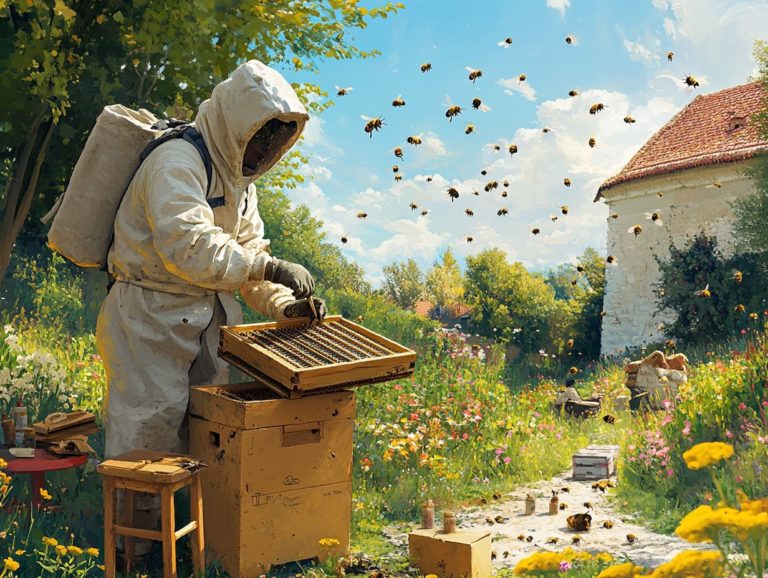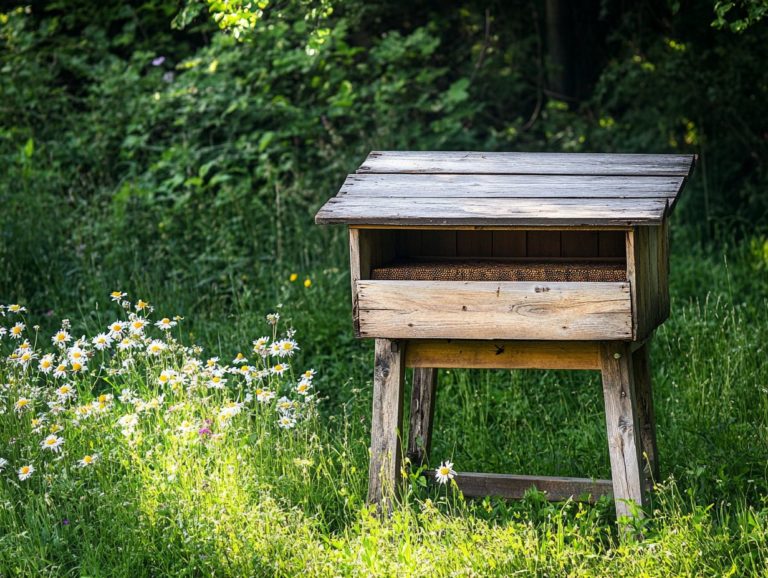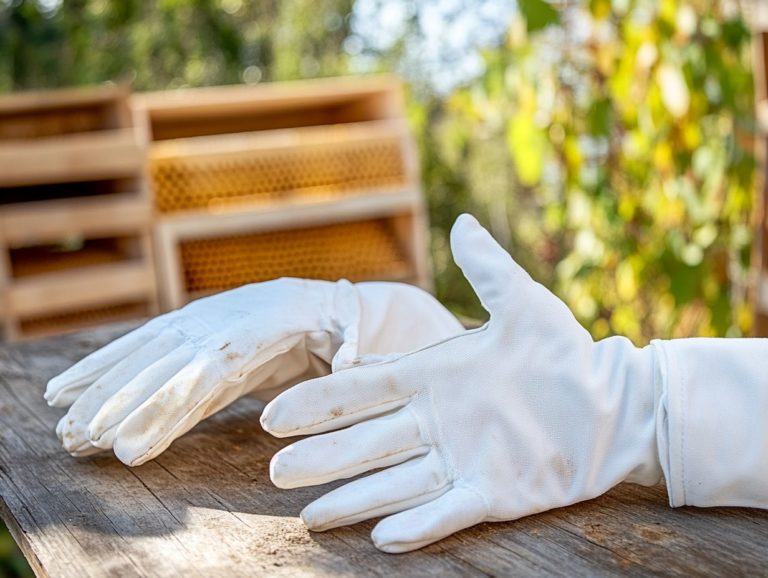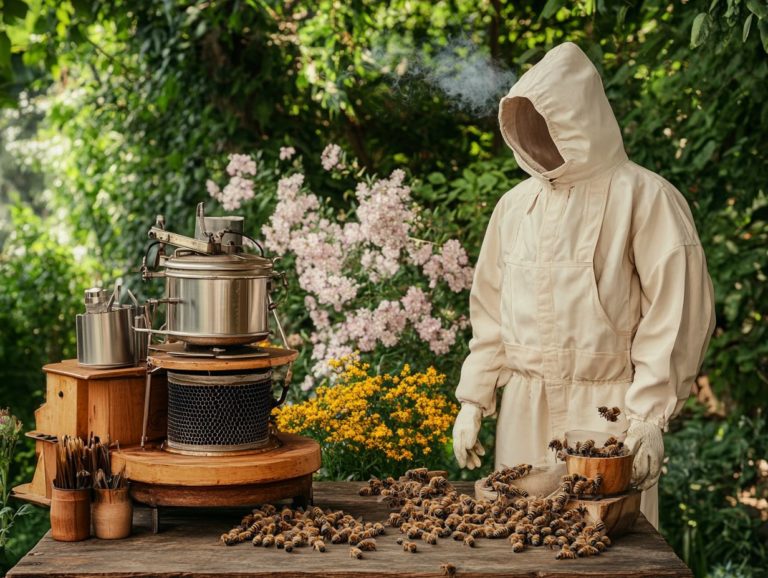How to Measure Your Hive’s Honey Production
Measuring your hive’s honey production is essential for both seasoned beekeepers and enthusiastic newcomers alike. Knowing exactly how much honey your bees are producing is crucial for a successful harvest, as it helps in effective beekeeping and optimal hive management.
By understanding how much honey your bees produce, you can manage your hive better, monitor bee activity, and truly maximize your harvest. This guide will walk you through the essential tools required, such as hive scales, frame scales, and IoT sensors, while providing clear, step-by-step instructions for measuring honey production.
You ll learn how to accomplish all of this with minimal disturbance to your bees, ensuring a healthy and productive hive. Dive in to discover the best methods for tracking your sweet success, including using data to gain better insights!
Contents
- Key Takeaways:
- Why Measure Your Hive’s Honey Production?
- What Tools Do You Need to Measure Honey Production?
- How to Measure Honey Production Using a Hive Scale?
- How to Measure Honey Production Using a Frame Scale?
- How to Measure Honey Production Using a Measuring Cup?
- How to Measure Honey Production Without Disturbing the Bees?
- What to Do with the Measured Honey?
- Data Monitoring in Beekeeping
Key Takeaways:
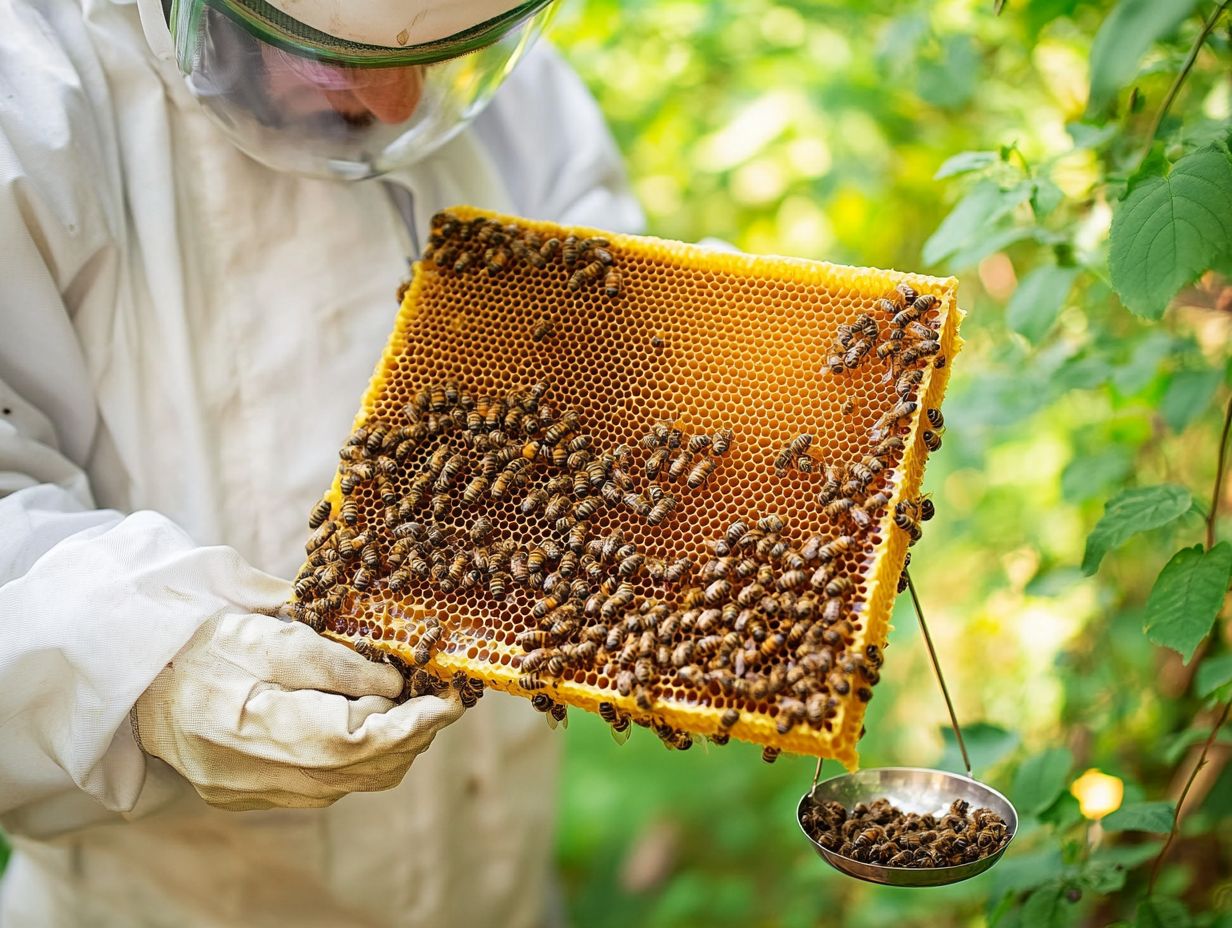
- Measuring your hive’s honey production can help you track the health of your colony and determine when to harvest honey.
- To measure honey production, you will need tools such as a hive scale, frame scale, measuring cup, bee brush, and sensors for accurate data monitoring.
- When using a hive or frame scale, record the weight before and after harvesting honey to calculate the amount produced.
Why Measure Your Hive’s Honey Production?
Measuring your hive’s honey production is essential for evaluating the health and productivity of your bee colonies. It enables you to manage your hive better and adopt sustainable beekeeping techniques while considering the impact of pests and climate conditions.
By accurately monitoring honey yield, you can better adapt to environmental changes, such as changes in temperature and humidity, which can profoundly influence nectar foraging and the overall well-being of your colony.
Analyzing data enables you to make informed decisions that not only boost honey production but also promote ecological sustainability and conservation of bee species.
What Tools Do You Need to Measure Honey Production?
To effectively measure honey production, you ll need specific tools that enable accurate assessments of your hives, ensuring optimal management and maximizing your harvest potential.
Essential tools such as hive scales, frame scales, measuring cups, and bee brushes are crucial for gathering precise data on honey yield and hive activity. By utilizing these instruments and IoT technologies, you can monitor the health of your colonies and adapt your techniques to changing environmental conditions.
1. Hive Scale
A hive scale is an essential tool for you as a beekeeper, enabling continuous monitoring of your hive’s weight to assess both honey production and the overall health of your colony. By placing the hive scale beneath your hive, you can gather data that reveals changes in weight indicators of honey accumulation and bee activity.
This real-time monitoring enables you to make timely decisions about hive management, ensuring optimal conditions for your bees while maximizing honey yield during the harvest season.
Setting up a hive scale is straightforward. It typically involves a sturdy base that supports the hive along with sensors that accurately measure weight changes over time. This functionality assists you in tracking honey production and bee activity.
As you analyze the collected data, patterns will emerge, providing valuable insights into your colony’s needs and behaviors throughout different seasons. This ultimately leads to improved management strategies and a deeper understanding of colony health dynamics, encouraging practices that enhance both the longevity and productivity of your hive.
Start measuring your hive’s honey production today for a bountiful harvest!
2. Frame Scale
A frame scale is an essential tool that enables you as a beekeeper to measure the weight of individual frames within your hive. This tool offers a deeper understanding of honey production. By evaluating how much honey is stored on each frame, you can efficiently gauge the overall yield and health of your colony. It also helps to identify frames that may need additional boxes for more honey storage or extra care.
This precise data is invaluable for optimizing hive conditions and refining your honey harvesting techniques.
When you utilize a frame scale effectively, you significantly enhance your ability to make informed decisions about hive management. Regularly measuring the weight of the frames reveals patterns in honey production, enabling you to implement timely interventions when necessary.
This systematic approach ensures that you maximize honey output while keeping a close eye on the overall well-being of your colonies. Measuring at the frame level provides critical insights into seasonal trends and colony behavior, allowing you to craft tailored strategies that lead to more successful honey production.
In essence, using a frame scale can revolutionize your beekeeping! Incorporating it into your practices transforms raw data into actionable insights, paving the way for improved yield and greater sustainability for your hives.
3. Measuring Cup
A measuring cup is a deceptively simple yet essential tool for you as a beekeeper assessing honey production. It allows for the precise measurement of harvested honey from the frames. By scraping honey into the measuring cup, you can easily determine the total amount collected, which can then be analyzed to identify production trends over time.
This hands-on method beautifully complements other data collection techniques, providing a tactile way to understand honey yield and ensuring accurate tracking of hive productivity.
Using a measuring cup not only aids in immediate measurement but also deepens your understanding of overall hive health and productivity levels. It s essential for you to tackle any challenges that arise during this process, such as scraping the honey correctly to avoid underestimating your yields.
After you fill the measuring cup, taking detailed notes will allow for more effective comparisons with previous harvests. When used alongside tools like refractometers, sensors, and hive scales, this practical method becomes part of a comprehensive monitoring strategy, enabling you to make informed decisions about your apiary management and production techniques.
4. Bee Brush
A bee brush is an essential tool for you as a beekeeper, allowing you to delicately remove bees from frames while measuring honey, all without subjecting the colony to unnecessary stress. By using a bee brush, you help maintain the integrity of the hive while ensuring accurate measurement and assessment of honey production. This technique is especially useful when dealing with different species of bees and varying hive conditions.
This tool proves especially beneficial when inspecting frames for honey content, ensuring that the overall activity of the bees remains undisturbed throughout the harvesting process.
By minimizing disruption to the bees, this straightforward yet effective implement nurtures a calm atmosphere within the hive, which is vital for safeguarding the colony’s health and productivity. A well-managed hive flourishes when the worker bees can concentrate on their essential tasks, such as nectar foraging and honeycomb building, resulting in improved honey yields and stronger populations.
Incorporating gentle methods like this into your honey extraction process aligns perfectly with best practices for sustainable beekeeping. Ultimately, this approach enables you to implement effective management strategies that not only benefit the bees but also enhance the quality of the honey you produce.
How to Measure Honey Production Using a Hive Scale?
Measuring honey production with a hive scale is a simple yet invaluable process that offers you essential insights into your hive’s yield and overall health.
Begin by placing the hive scale beneath the hive to capture an initial weight reading; this will serve as your baseline for future measurements. By regularly monitoring the hive’s weight, you can effectively analyze honey accumulation and colony activity.
This data-driven approach enables you to make informed decisions that not only enhance productivity but also ensure the long-term sustainability of your beekeeping practices.
Don’t miss out on the chance to optimize your honey output! Start using these essential tools today for a more successful beekeeping experience.
1. Place the Hive Scale Under the Hive
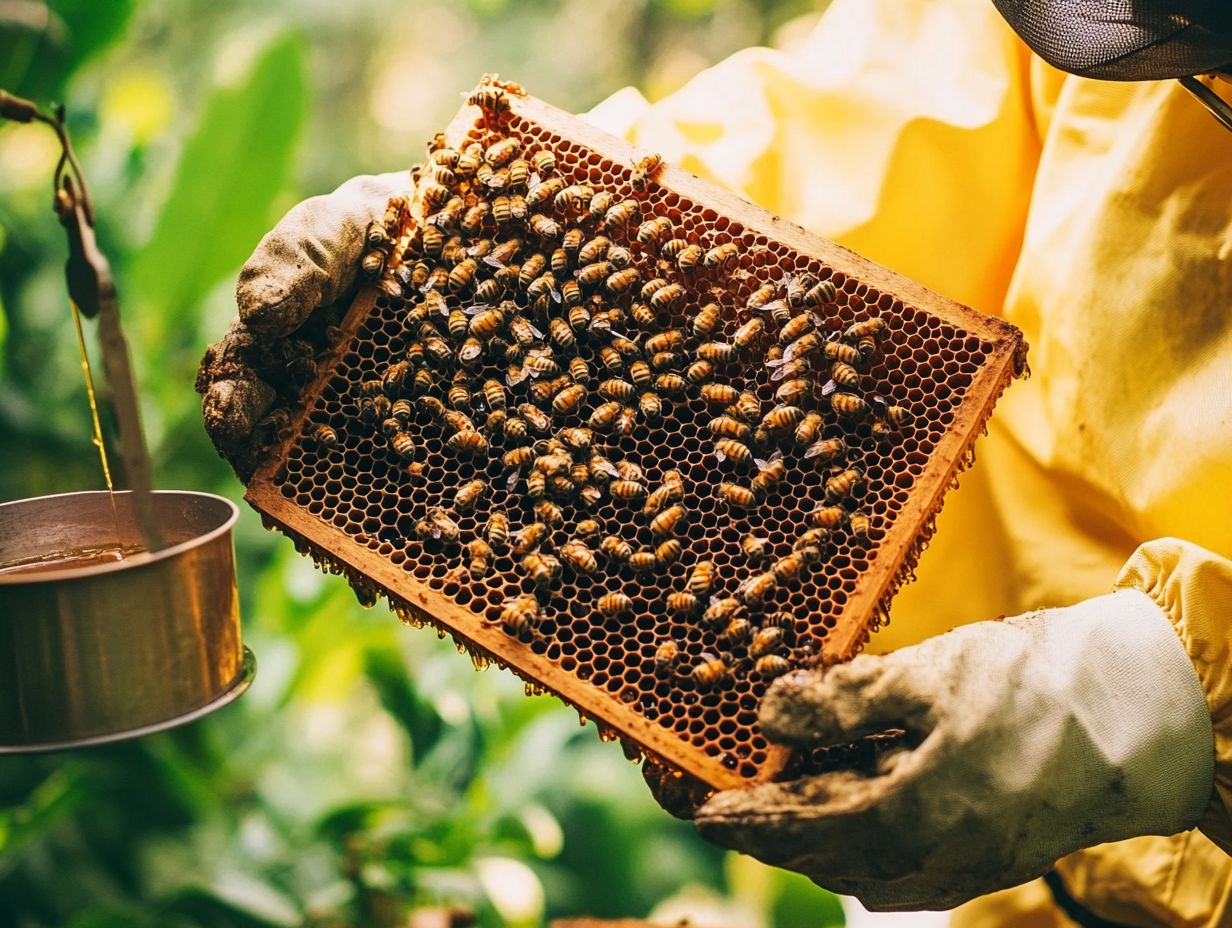
Placing the hive scale under the hive is your first crucial step in measuring honey production. This placement lets you check the weight over time, ensuring accurate weight readings of the entire hive and its contents.
It allows for continuous monitoring of the hive’s weight, which is essential for tracking honey accumulation and bee activity. Proper positioning of the scale is vital for data accuracy; any obstruction or incorrect placement could lead to misleading results.
To achieve optimal placement, level the scale on a stable surface. Make sure it s free from debris or uneven ground. Position the scale so that it sits directly under the hive entrance. This avoids skewed measurements from weight imbalances.
Regularly checking the scale’s calibration will enhance its reliability, especially during those critical periods of honey flow. Accurate data is your secret weapon for successful beekeeping!
Even slight variances can significantly impact your predictions for honey production rates and the overall health of the colony. Leveraging this data can help you better understand the effects of weather and environmental factors on honey yield.
2. Record the Weight of the Hive
Recording the weight of your hive is crucial for establishing a solid baseline for honey production measurements. After you set up the hive scale, note the initial weight. This figure acts as your reference point for future readings, allowing you to track honey accumulation effectively.
This data reveals valuable insights into your hive’s productivity and is a powerful tool for making informed decisions about hive management. Don t wait! Schedule regular measurements now ideally on a weekly or bi-weekly basis during peak honey flow seasons.
This ensures that fluctuations in weight genuinely reflect actual honey production, instead of being influenced by external factors. Keeping a detailed log of these weights, along with notes on environmental conditions and hive treatment plans, is essential.
Recognizing patterns over time will enable you to anticipate honey yields and adjust your management strategies as needed. This could mean maximizing your harvests or addressing potential issues within the hive.
Ultimately, systematic weight recording contributes to a proactive approach to beekeeping, enhancing both the health and productivity of your bees.
3. Calculate the Difference in Weight
Calculating the difference in weight over time allows you to gauge honey production accurately and assess the health of your colonies. By taking subsequent measurements with the hive scale and subtracting the initial weight from the current weight, you can determine exactly how much honey has been produced since your last reading.
This simple method helps you understand production trends and informs your hive management strategies based on colony activity. These weight calculations are vital indicators of overall hive vitality.
A steady increase in weight often signals that your colony is thriving, while notable fluctuations or weight loss may hint at issues such as disease or insufficient resources.
By regularly monitoring these measurements, you can make informed decisions like when to harvest or whether additional feeding might be necessary ultimately leading to improved management practices. Incorporating these calculations into your routine fosters healthier colonies and enhances honey production, essential for a thriving operation.
How to Measure Honey Production Using a Frame Scale?
Measuring honey production with a frame scale, a device used to measure the weight of individual frames in a hive, provides you with an intricate view of honey distribution across those frames.
By accurately weighing each frame, you can refine your harvesting strategies and monitor the health of your colonies with greater precision. This targeted measurement approach facilitates precise data collection, enabling you to make informed decisions that foster sustainable beekeeping practices and enhance your honey yield.
1. Remove a Frame from the Hive
Removing a frame from the hive is your first critical step in measuring honey production with a frame scale. This allows you to assess the honey content with precision. Careful extraction ensures minimal disturbance to the colony, preserving the overall health of the hive throughout the measurement process. This technique is essential for obtaining accurate data on how much honey is stored and can be harvested, ultimately influencing your management practices and production yield.
By prioritizing gentle handling techniques, you significantly reduce stress on the bees something vital for maintaining a productive and thriving hive. When you remove frames with a steady hand and in a calm environment, the bees are far less likely to panic. This allows them to quickly resume their normal activities. This thoughtful approach promotes hive stability and aids in accurate honey measurements, providing you with deeper insights into your production levels.
Understanding these metrics leads to more effective colony management and improved strategies for future harvests.
2. Place the Frame on the Scale
Placing the removed frame on the scale is crucial for obtaining accurate weight measurements of the honey it contains. This step enables you to assess honey content more effectively, as weighing the frame before and after extraction offers valuable insights into production levels. Ensuring proper placement on the scale guarantees precise results, enabling you to make informed, data-driven decisions regarding honey harvesting and hive management.
Achieving this level of precision requires attention to several details, such as ensuring the scale is on a level surface and that the frame is clean and free from any debris that could distort the results. Keep in mind that environmental factors like humidity and temperature can also influence the honey’s weight. Thus, it is essential to conduct measurements under consistent conditions.
This meticulous approach to weighing reflects the current state of your honey stores and aids in forecasting future harvesting strategies. By mastering this step, you significantly enhance your hive management techniques and optimize your honey yield.
3. Record the Weight of the Frame
Recording the weight of the frame after placing it on the scale is essential for tracking honey production accurately and managing hive performance effectively. This data not only reflects the amount of honey stored but also plays a crucial role in evaluating the overall health and productivity of your colony. By keeping meticulous records of frame weights, you can identify trends in honey yield and adjust your management practices as needed.
To truly maximize the benefits of this practice, create a dedicated logbook or digital spreadsheet where you document all weight measurements immediately after your checks. Each entry should include the date, frame identification, and weight. This makes it easier for you to compare data over time. Analyzing these records enables you to make informed strategic decisions, such as determining the optimal time to harvest or assessing whether supplementary feeding is necessary.
Engaging in detailed analytics from consistent record-keeping can lead to better resource allocation and enhanced hive management, ultimately elevating both your yield and the health of your colony.
4. Calculate the Amount of Honey on the Frame
Calculating the amount of honey on the frame involves determining the difference between the frame’s empty weight and its weight after honey extraction. This is a crucial step for accurately measuring honey production.
To begin this process, use a reliable scale to weigh each frame before and after you extract the honey. This isn t just a casual affair; beekeepers often collect this data methodically, jotting down weights in a dedicated journal or utilizing specialized software designed for hive management.
With these measurements in hand, you can pinpoint underperforming frames and fine-tune your practices accordingly. Knowing the weight of your honey helps you predict harvest times with greater accuracy, contributing to improved hive health and maximizing your production potential.
This meticulous analysis not only boosts how well your hive is running but also deepens your understanding of how the bees within the hive interact and work together, ultimately leading to more successful honey production efforts.
How to Measure Honey Production Using a Measuring Cup?
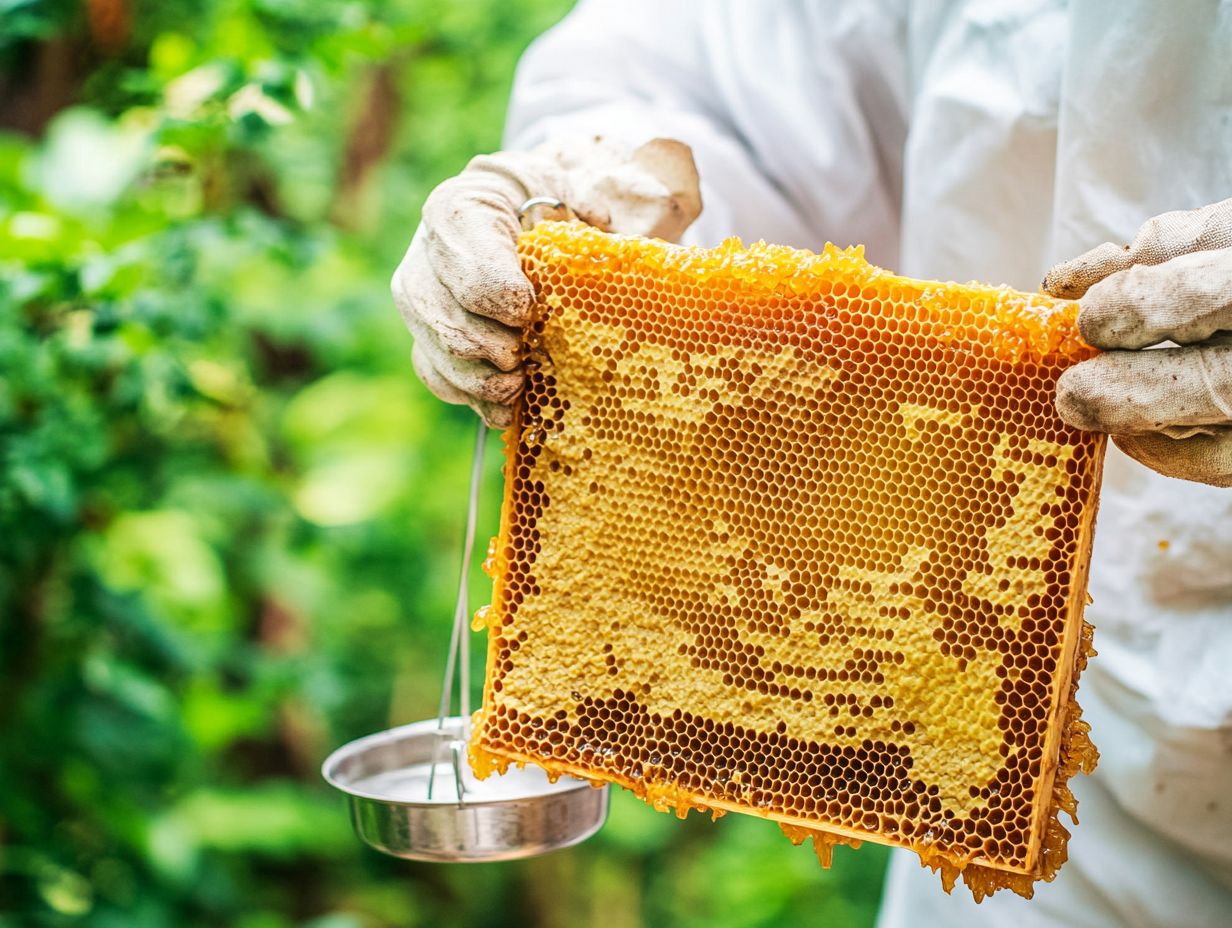
Using a measuring cup to evaluate honey production is simple and effective. It helps you get precise measurements of the honey harvested from your frames.
This hands-on method is not only simple but also incredibly valuable during the harvesting process. It gives you immediate insights into honey yield and important information about your hive’s overall productivity.
By using this measurement approach in your regular monitoring, you improve your understanding of your colony’s performance. This supports your best management of beekeeping efforts.
1. Remove a Frame from the Hive
The first step in measuring honey production is to remove a frame from the hive. This careful removal allows you to capture the honey stored within accurately.
Approach the hive calmly and use gentle motions while extracting frames. Sudden movements can stress the bee colony.
Take your time when unsecuring the frame. This reduces the likelihood of agitating the bees and ensures a smoother process.
By focusing on the bees’ well-being during frame removal, you protect their health. You also improve the accuracy of your honey measurements, reflecting the hive’s productivity reliably.
2. Scrape the Honey into the Measuring Cup
Scraping honey into the measuring cup is crucial. It allows for an accurate measurement of honey harvested from the frame.
This method gives you direct insight into your honey yield. It helps you analyze your production levels effectively.
Use a clean, dry spatula with a defined edge. This helps you collect honey smoothly without leaving residues behind.
Scrape slowly to let honey flow into the measuring cup. This reduces drips and spills, keeping your process clean.
Conduct this task in a warm, dry environment. Proper humidity control helps maintain the honey s thickness, making scraping easier.
These practices elevate honey quality by preventing contamination. They also ensure more reliable yield data for effective hive management.
3. Record the Amount of Honey
Recording the amount of honey after scraping it into the measuring cup is crucial for tracking production. This process helps you evaluate your hive’s performance over time.
Keeping meticulous records allows you to make informed decisions for sustainable practices. This optimizes your honey yields while ensuring hive health.
Be sure to document measurements immediately! This minimizes the chance of forgetting details and keeps your data accurate.
Tools like spreadsheets or mobile apps can streamline your recordkeeping. They make it easier to spot trends over time.
Organizing your data helps identify patterns in honey production related to weather conditions, forage availability, temperature, and hive health. These insights help you know the best times to harvest and manage your resources effectively.
How to Measure Honey Production Without Disturbing the Bees?
Measuring honey production without disturbing the bees is crucial for preserving hive health and minimizing stress on the colony during assessments. This is especially important during seasonal conditions. By employing tools such as a bee brush, you can gently remove bees from the frames. This allows for precise measurement of the honey stored while keeping the colony undisturbed.
This approach helps protect the bees and cultivates a more productive atmosphere for honey production. Ultimately, it elevates your overall hive management practices.
1. Use a Bee Brush to Gently Remove Bees from the Frame
Using a bee brush to gently remove bees from the frame is a technique you ll find invaluable for measuring honey production. This method minimizes stress on the colony and ensures minimal impact on hive activity. This handy tool allows for meticulous handling of the bees, safely brushing them away while preserving the integrity of the hive.
Employing such gentle methods is essential for maintaining bee health during measurement activities. It is a cornerstone of sustainable beekeeping practices, particularly when dealing with different bee species.
When you use a soft-bristled bee brush, you minimize the risk of injuring the bees, which can spike stress levels within the colony. This attention to detail not only helps retain your worker bees but also boosts their productivity. They can stay calm and focused on their vital tasks.
A less-disturbed environment encourages the bees to return swiftly to foraging and brood care. This keeps the hive healthy and enhances their nectar collection. This careful method boosts your honey yields, as a harmonious bee environment is directly linked to their efficiency in honey production.
2. Work Quickly and Carefully
Working quickly and carefully during honey measurement is essential for minimizing stress on your bees. This ensures efficient data collection, aided by modern IoT sensors devices that connect to the internet to collect information. As a beekeeper, your goal should be to complete assessments swiftly while keeping the well-being of the bees in mind. Prolonged exposure can lead to agitation within the hive.
One effective strategy is to pre-plan your measurement process. Have all necessary tools ready to reduce the time spent in the hive. Utilizing tools specifically designed for quick and accurate honey extraction can significantly streamline your workflow.
This approach decreases the risk of disturbing the bees while allowing for timely assessments. Your decisions will inform better hive management.
By prioritizing both speed and caution, you can create a stable atmosphere in the apiary. This supports bee longevity and enhances your honey yield amidst varying climate conditions.
What to Do with the Measured Honey?
Once you ve measured your honey, you have many options for utilizing your harvest. From proper storage techniques to selling and incorporating honey into various applications, the possibilities are abundant.
Effective storage practices are crucial for maintaining the honey s quality and preventing spoilage. This ensures it remains fresh for your enjoyment or for consumers. Proper techniques promote sustainability and support local economies.
If you sell your honey, you contribute to local agriculture and support sustainability efforts.
Get creative with your honey! Explore countless delicious recipes and uses. Start experimenting with your honey today!
1. Store the Honey
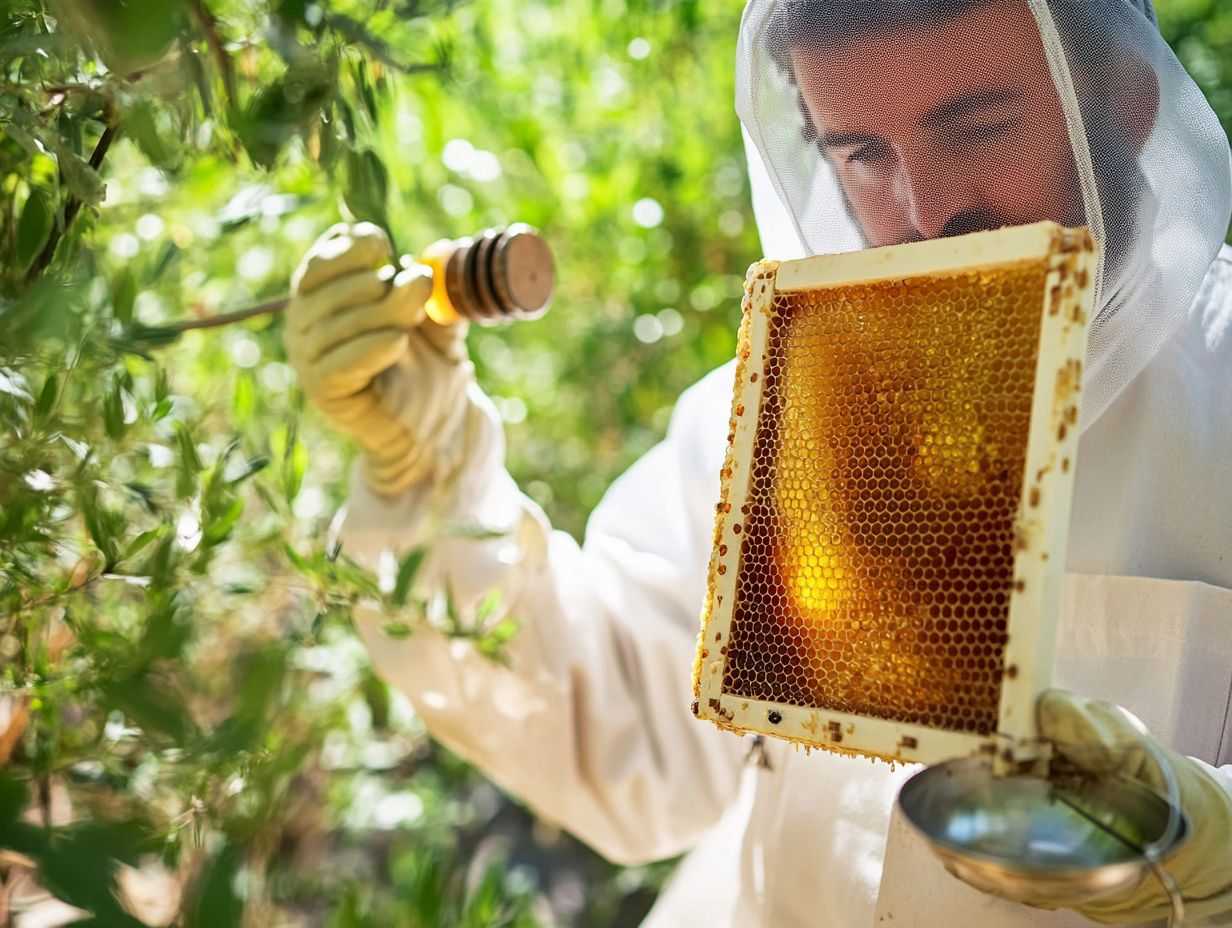
Storing honey properly is vital for maintaining its quality and extending its shelf life. It s essential to grasp the best practices for honey storage.
Choosing the right type of container is crucial. Glass jars are highly recommended because they provide an airtight seal and won t react with honey’s natural acids. Containers should be kept in an optimal environment to maintain honey quality. While plastic containers are an option, they should be exclusively designated for honey to prevent any lingering odors or flavors from previous contents.
To preserve your honey’s integrity, keep it away from direct sunlight. Extreme temperatures can also degrade its quality. By maintaining the purity and quality of honey, you meet consumer expectations and contribute to broader conservation efforts. This fosters sustainable interactions with bee populations and their habitats.
Start storing your honey with these tips today!
2. Sell or Use the Honey
As a beekeeper, you have the rewarding choice to either sell or utilize the honey you harvest. This choice makes a significant impact on local agriculture while championing sustainable practices and conservation efforts. Selling your honey creates extra money that supports your beekeeping endeavors and bolsters the local economy.
You can harness honey s versatility in culinary applications or medicinal uses. This showcases its numerous health benefits while emphasizing the critical importance of conservation in your beekeeping efforts.
You can explore different places to sell your honey, like local farmers’ markets, online platforms, or direct-to-consumer sales. Each option offers unique pricing strategies that reflect the exceptional quality and character of the honey you produce. Setting competitive prices can attract customers who value organic and locally sourced products, thereby enhancing your market presence.
Honey’s diverse applications in the kitchen whether sweetening beverages, glazing meats, or enriching baked goods demonstrate its essential value in everyday life. Have you ever thought about how sweet your honey could be in a glaze for meats? It’s a game-changer!
Beyond culinary uses, honey has gained recognition in wellness circles for its soothing properties, making it a sought-after choice for natural remedies. This not only fuels the demand for local honey but also reinforces the vital connection between sustainable agricultural practices and community health.
Data Monitoring in Beekeeping
Frequently Asked Questions
- What is the best way to measure my hive’s honey production?
- The most accurate way is to use a scale placed under the hive. This can be combined with sound monitoring and other IoT sensors (Internet of Things sensors that track weight and environmental conditions). This setup provides the exact weight of the honey produced by your bees.
- How often should I measure my hive’s honey production?
- Make it a habit to check your hive’s honey production at least once a month, preferably at the end of each month. This practice takes various seasonal and environmental factors into account and gives you a good understanding of your hive’s production throughout the year.
- Can I measure my hive’s honey production without a scale?
- Yes, you can estimate your hive’s honey production by visually inspecting the honey frames and estimating the weight based on the number of filled frames. Understanding hive activity and foraging patterns can improve accuracy. However, this method may not be as accurate as using a scale.
- What should I do if my hive’s honey production seems low?
- If you believe your hive’s honey production is low, the first step is to check the health of your hive. Ensure the bees have enough resources, such as food and space, and that there are no signs of disease, pests, or any other environmental conditions affecting them. If everything seems normal and your hive is still not producing enough honey, consider consulting a local beekeeper or expert for advice. Engaging with experienced beekeepers can provide insights on the impact of climate and weather on honey production.
Can I use different techniques to measure my hive’s honey production?
Yes, you can use various techniques to measure your hive’s honey production. You can count the number of frames filled with honeycomb, estimate the honey visually, or use a refractometer, which measures sugar content.
However, the most accurate method is using a scale. Advanced technologies, like IoT sensors, can also help monitor hive weight and activity.
How can I use the data and analytics from measuring my hive’s honey production?
The data you collect can help track the health and productivity of your hive. This information allows you to make informed decisions about hive management, such as when to add or remove honey supers and when to harvest.
Analytics can provide valuable insights into bee foraging patterns and seasonal impacts on honey yield. Monitoring environmental factors like temperature and humidity will enhance your understanding of hive performance.

